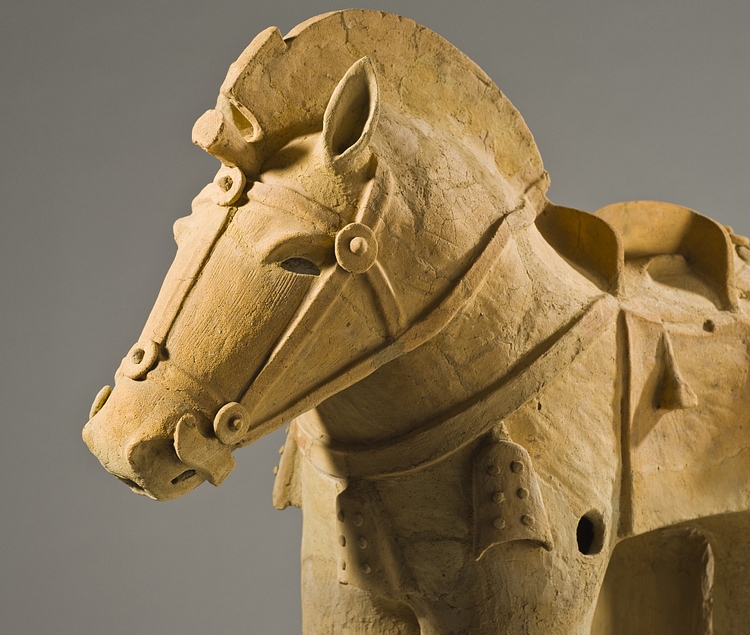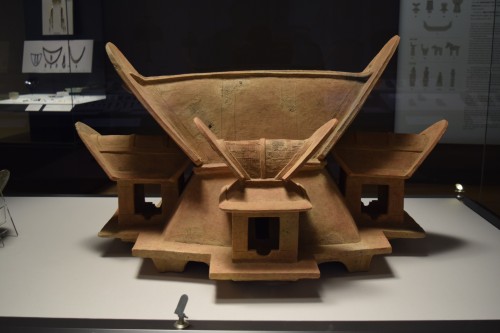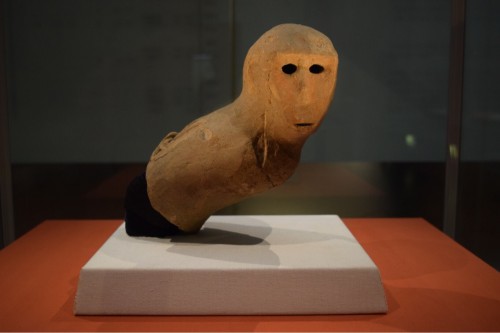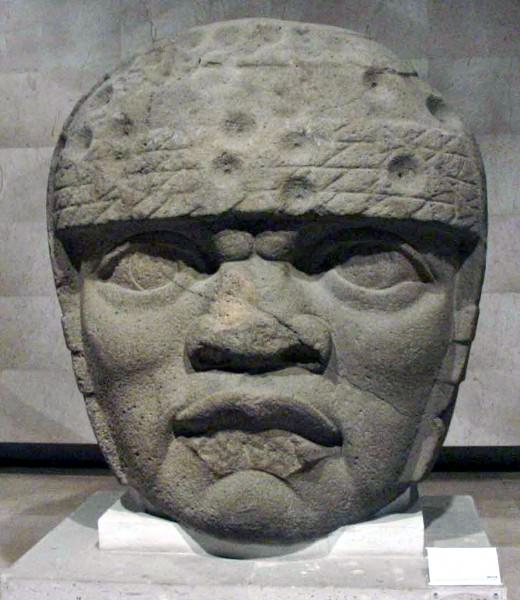Haniwa › Olmec Colossal Stone Heads » Origins and History
Articles and Definitions › Contents
- Haniwa › Ancient History
- Olmec Colossal Stone Heads › Antique Origins
Ancient civilizations › Historical places, and their characters
Haniwa › Ancient History
Definition and Origins

Haniwa are the unglazed terracotta rings, cylinders, and figures of people, animals, and houses which were deposited at Japanese tombs during the Kofun and Asuka Periods (c. 250-710 CE). The exact purpose of these offerings is not known, although it seems likely they were examples of conspicuous consumption of the societal elite or performed some protective function. Many haniwa are particularly detailed in their execution and thus provide a valuable insight into the culture of the period. Standing over one metre in height, the mysterious figures are a striking example of early Japanese sculpture.
PURPOSE
These ritual objects were buried with the deceased interred in kofun (tumuli) tombs throughout the Yamato Period of ancient Japan from the 3rd century CE to the early 8th century CE. The period is often subdivided into the Kofun Period (c. 250-538 CE) and the Asuka Period (538-710 CE). Early tombs were more modest, but by the 5th century CE, they had developed into huge earth mounds. The practice spread throughout Japan so that the islands boast some 20,000 burial mounds known today. They follow a similar design with a keyhole-shaped inner tomb covered by an earth mound and surrounded by a moat.The biggest is the tomb of Emperor Nintoku which is 823 metres long. The earliest examples of haniwa discovered are concentrated in the Nara region. Unusually for votive offerings, haniwa were not placed within the tomb itself but near it or on top of it in either a circle or rows.

Haniwa Figurine
THE NAME HANIWA MEANS 'CLAY RING' BUT THE TERRACOTTA OBJECTS TODAY GIVEN THAT LABEL REPRESENT A WIDE RANGE OF FIGURINES.
The precise significance of these offerings is unclear, but in all probability, they substituted real objects and displayed the wealth and status of the individual interred in the large tumuli which were themselves reserved for the society's elite, such was the labour needed to build them. The Nihon Shoki ('Chronicle of Japan' and also known as the Nihongi ), written in 720 CE, suggests that haniwa were replacements for the chieftain's attendants, it being a common feature of ancient societies to bury the slaves of a ruler with their master. This does not, however, explain those haniwa which are simply rings or cylinders, which constitutes the majority. Although it may be that the cylinders were originally meant as stands for the more elaborate figures.

Haniwa House
Another theory is that haniwa acted as protective spirits for the deceased and ensured the tomb was not disturbed. Certainly, Korean tumuli in the contemporary Silla kingdom, which may well have influenced Japanese culture, employed stone sculptures of animal signs for just that purpose. Finally, the haniwa may have protected not the dead but the living from the spirit of the deceased chief, ancestor worship and a reverence for spirits or kami being long-held beliefs in ancient Japan.

Monkey Haniwa
SHAPES & FORMS
The name haniwa means 'clay ring' but the coarse red terracotta objects today given that label represent a wide range of figurines of people and animals, and besides the simpler ring types and common cylinder forms, there are also representations of houses, fishing boats, and trading ships. Amongst the most intricate haniwa are human figures representing female shamans with elaborate headdresses or holding a mirror, helmeted warriors wearing armour, horseriding warriors with bows and arrows, women carrying babies on their backs or water vessels on their heads, farmers wielding hoes, musicians playing a drum or zither, and falconers with their hawk. Another common type is riderless horses with intricate saddles and bridles. Other animals include birds, dogs, deer, monkeys, rabbits, and sheep. Most haniwa are just under one metre in height but some are over 1.5 metres tall.
This article was made possible with generous support from the Great Britain Sasakawa Foundation.
Olmec Colossal Stone Heads › Antique Origins
Ancient Civilizations
The stone head sculptures of the Olmec civilization of the Gulf Coast of Mexico (1200 BCE - 400 BCE) are amongst the most mysterious and debated artefacts from the ancient world. The most agreed upon theory is that, because of their unique physical features and the difficulty and cost involved in their creation, they represent Olmec rulers.

Olmec Colossal Head
Seventeen heads have been discovered to date, 10 of which are from San Lorenzo and 4 from La Venta; two of the most important Olmec centres. The heads were each carved from a single basalt boulder which in some cases were transported 100 km or more to their final destination, presumably using huge balsa river rafts wherever possible and log rollers on land.The principal source of this heavy stone was Cerro Cintepec in the Tuxtla Mountains. The heads can be nearly 3 m high, 4.5 metres (9.8 feet, 14.7 feet) in circumference and average around 8 tons in weight. The heads were sculpted using hard hand-held stones and it is likely that they were originally painted using bright colours. The fact that these giant sculptures depict only the head may be explained by the widely held belief in Mesoamerican culture that it was the head alone which contained the emotions, experience, and soul of an individual.
Facial details were drilled into the stone (using reeds and wet sand) so that prominent features such as the eyes, mouth, and nostrils have real depth. Some also have deliberately drilled dimples on the cheeks, chin, and lips. The heads all display unique facial features - often in a very naturalistic and expressive manner - so that they may be considered portraits of actual rulers. The scholar ME Miller identifies Colossal Head 5, for example, as a second-millenium BCE ruler of San Lorenzo.Although the physionomy of the sculptures has given rise to unfounded speculation of contact with civilizations from Africa, in fact, the physical features common to the heads are still seen today in residents of the modern Mexican cities of Tabasco and Veracruz.

Olmec Colossal Stone Head
The subject often wears a protective helmet which was worn by the Olmec in battle and during the Mesoamerican ballgame.These can vary in design and pattern and sometimes the subject also has jaguar paws hanging over the forehead, perhaps representing a jaguar pelt worn as a symbol of political and religious power, a common association in many Mesoamerican cultures. Colossal Head 1 from La Venta, instead, has huge talons carved on the front of the helmet.
MANY OF THE STONES ARE DIFFICULT TO PLACE IN THEIR ORIGINAL CONTEXT AS THEY WERE NOT NECESSARILY FOUND IN THE POSITIONS THE OLMECS HAD ORIGINALLY PUT THEM.
Some heads are also recarvings of other objects. For example, San Lorenzo Colossal Head 7 was originally a throne and has a deep indentation on one side and Altar 5 from La Venta seems to have been abandoned in the middle of such a conversion.Miller suggests that perhaps a specific ruler's throne was converted into a colossal portrait in an act of remembrance following that ruler's death.
Many of the stones are difficult to place in their original context as they were not necessarily found in the positions the Olmecs had originally put them. Indeed, Almere Read (41) suggests that even the Olmecs themselves regularly moved the heads around for different ritual purposes. Another theory is that the heads were used as powerful markers of rulership and distributed to declare political dominance in various territories. Interestingly, the four heads from La Venta were perhaps originally positioned with such a purpose in mind so that they stood as guardians to the sacred precinct of the city. Three were positioned at the northern end of the complex and the other one stood at the southern end; but all faced outwards as if protecting the precinct. These heads are very similar to the San Lorenzo heads but display a regional variance in that they are wider and more squat in appearance.

Olmec Colossal Stone Head
That the other heads might have been discovered out of their original setting is suggested by the fact that very often they show signs of deliberate vandalism and most were buried sometime before 900 BCE in what appears to have been a purposeful ritual distancing with the past. However, it has also been suggested that some of the heads were buried shortly after their production in a process of ancestor worship or that they were defaced and buried by subsequent rulers to legitimize their claim to power and exclude competing lineages. It could also be that they were even damaged in order to neutralize the dead ruler's power. Whatever the reason, the heads were buried and forgotten for nearly three thousand years until the first head was re-discovered, in 1871 CE, with the last being excavated as recently as 1994 CE.
LICENSE:
Article based on information obtained from these sources:with permission from the Website Ancient History Encyclopedia
Content is available under License Creative Commons: Attribution-NonCommercial-ShareAlike 3.0 Unported. CC-BY-NC-SA License